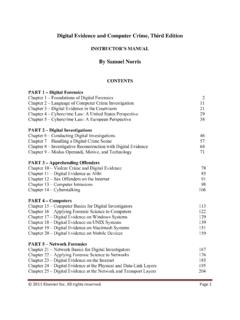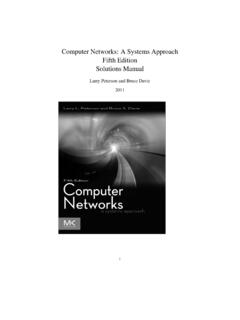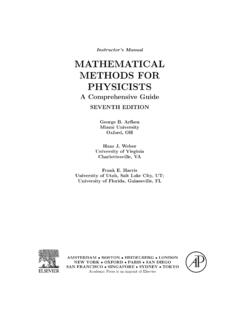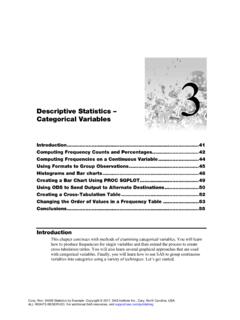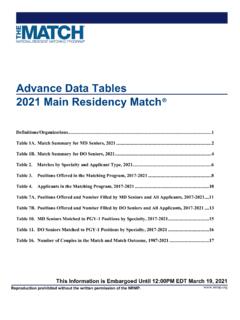Transcription of Data Mining: Concepts and Techniques
1 data Mining: Concepts andTechniques3rd EditionSolution ManualJiawei Han, Micheline Kamber, Jian PeiThe University of Illinois at Urbana-ChampaignSimon Fraser UniversityVersion January 2, 2012c Morgan Kaufmann, 2011 For Instructors' references not copy! Do not distribute!iiPrefaceFor a rapidly evolving field like data mining, it is difficult to compose typical exercises and even moredifficult to work out standard answers. Some of the exercises inData Mining: Concepts and Techniquesare themselves good research topics that may lead to future Master or theses. Therefore, our solutionmanual is intended to be used as a guide in answering the exercises of the textbook. You are welcome toenrich this manual by suggesting additional interesting exercises and/or providing more thorough, or betteralternative we have done our best to ensure the correctness of the solutions, it is possible that some typos orerrors may exist.
2 If you should notice any, please feel free to point them out by sending your suggestions We appreciate your assist the teachers of this book to work out additional homework or exam questions, we have addedone additional section Supplementary Exercises to each chapter of this manual. This section includesadditional exercise questions and their suggested answers and thus may substantially enrich the value of thissolution manual. Additional questions and answers will be incrementally added to this section, extractedfrom the assignments and exam questions of our own teaching. To this extent, our solution manual will beincrementally enriched and subsequently released in the future months and to the current release of the solution to the limited time, this release of the solution manual is a preliminary version. Many of the newlyadded exercises in the third edition have not provided the solutions yet.
3 We apologize for the will incrementally add answers to those questions in the next several months and release the new versionsof updated solution manual in the subsequent each edition of this book, the solutions to the exercises were worked out by different groups of teachassistants and students. We sincerely express our thanks to all the teaching assistants and participatingstudents who have worked with us to make and improve the solutions to the questions. In particular, for thefirst edition of the book, we would like to thanksDenis M. C. Chai, Meloney Chang, James W. Herdy,Jason W. Ma, Jiuhong Xu, Chunyan Yu, andYing Zhouwho took the class ofCMPT-459: data Mining andData Warehousingat Simon Fraser University in the Fall semester of 2000 and contributed substantially tothe solution manual of the first edition of this book. For those questions that also appear in the first edition,the answers in this current solution manual are largely based on those worked out in the preparation of thefirst the solution manual of the second edition of the book, we would like to thank students andteaching assistants,Deng CaiandHector Gonzalez, for the courseCS412: Introduction to data Mining andData Warehousing, offered in the Fall semester of 2005 in the Department of Computer Science at theUniversity of Illinois at Urbana-Champaign.
4 They have helped prepare and compile the answers for the newexercises of the first seven chapters in our second edition. Moreover, our thanks go to several students fromtheCS412class in the Fall semester of 2005 and theCS512: data Mining: Principles and Algorithmsclassesiiiivin the Spring semester of 2006. Their answers to the class assignments have contributed to the advancementof this solution the solution manual of the third edition of the book, we would like to thank students,Jialu Liu,Brandon NorickandJingjing Wang, in the courseCS412: Introduction to data Mining and data Warehousing,offered in the Fall semester of 2011 in the Department of Computer Science at the University of Illinoisat Urbana-Champaign. They have helped checked the answers of the previous editions and did manymodifications, and also prepared and compiled the answers for the new exercises in this edition.
5 Moreover,our thanks go to teaching assistants,Xiao Yu, Lu An Tang, Xin JinandPeixiang Zhao, from theCS412classand theCS512: data Mining: Principles and Algorithmsclasses in the years of 2008 2011. Their answersto the class assignments have contributed to the advancement of this solution Exercises .. Supplementary Exercises ..72 Getting to Know Your Exercises .. Supplementary Exercises ..183 data Exercises .. Supplementary Exercises ..314 data Warehousing and Online Analytical Exercises .. Supplementary Exercises ..475 data Cube Exercises .. Supplementary Exercises ..676 Mining Frequent Patterns, Associations, and Correlations: Basic Concepts and Methods Exercises .. Supplementary Exercises ..787 Advanced Pattern Exercises .. Supplementary Exercises ..888 Classification: Basic Exercises .. Supplementary Exercises.
6 999 Classification: Advanced Exercises .. Supplementary Exercises ..10510 Cluster Analysis: Basic Concepts and Exercises .. Supplementary Exercises ..115vCONTENTS111 Advanced Cluster Exercises ..12312 Outlier Exercises ..12713 Trends and Research Frontiers in data Exercises .. Supplementary Exercises ..1392 CONTENTSC hapter isdata mining? In your answer, address the following:(a)Is it another hype?(b)Is it a simple transformation or application of technology developed fromdatabases,statistics,machine learning, andpattern recognition?(c)We have presented a view that data mining is the result of the evolution ofdatabase you think that data mining is also the result of the evolution ofmachine learning research?Can you present such views based on the historical progress of this discipline? Do the same forthe fields ofstatisticsandpattern recognition.
7 (d)Describe the steps involved in data mining when viewed as a process of knowledge : data miningrefers to the process or method that extracts or mines interesting knowledge orpatterns from large amounts of data .(a)Is it another hype? data mining is not another hype. Instead, the need for data mining has arisen due to the wideavailability of huge amounts of data and the imminent need for turning such data into usefulinformation and knowledge. Thus, data mining can be viewed as the result of the natural evolutionof information technology.(b)Is it a simple transformation of technology developed from databases, statistics, and machinelearning?No. data mining is more than a simple transformation of technology developed from databases,statistics, and machine learning. Instead, data mining involves an integration, rather than asimple transformation, of Techniques from multiple disciplines such as database technology, statis-tics, machine learning, high-performance computing, pattern recognition, neural networks, datavisualization, information retrieval, image and signal processing, and spatial data analysis.
8 (c)Explain how the evolution of database technology led to data technology began with the development of data collection and database creation mech-anisms that led to the development of effective mechanisms for data management including datastorage and retrieval, and query and transaction processing. The large number of database sys-tems offering query and transaction processing eventually and naturally led to the need for dataanalysis and understanding. Hence, data mining began its development out of this 1. INTRODUCTION(d)Describe the steps involved in data mining when viewed as a process of knowledge steps involved in data mining when viewed as a process of knowledge discovery are as follows: data cleaning, a process that removes or transforms noise and inconsistent data data integration, where multiple data sources may be combined data selection, where data relevant to the analysis task are retrieved from the database data transformation, where data are transformed or consolidated into forms appropriatefor mining data mining, an essential process where intelligent and efficient methods are applied inorder to extract patterns Pattern evaluation, a process that identifies the truly interesting patterns representingknowledge based on some interestingness measures Knowledge presentation, where visualization and knowledge representation Techniques areused to present the mined knowledge to the is adata warehousedifferent from a database?
9 How are they similar?Answer:Differences between a data warehouse and a database: Adata warehouseis a repository of informa-tion collected from multiple sources, over a history of time, stored under a unified schema, and usedfor data analysis and decision support; whereas adatabase, is a collection of interrelated data thatrepresents the current status of the stored data . There could be multiple heterogeneous databaseswhere the schema of one database may not agree with the schema of another. A database systemsupports ad-hoc query and on-line transaction processing. For more details, please refer to the section Differences between operational database systems and data warehouses. Similarities between a data warehouse and a database: Both are repositories of information, storinghuge amounts of persistent each of the followingdata mining functionalities: characterization, discrimination, associationand correlation analysis, classification, regression, clustering, and outlier analysis.
10 Give examples ofeach data mining functionality, using a real-life database that you are familiar :Characterizationis a summarization of the general characteristics or features of a target class ofdata. For example, the characteristics of students can be produced, generating a profile of all theUniversity first year computing science students, which may include such information as a high GPAand large number of courses a comparison of the general features of target class data objects with the generalfeatures of objects from one or a set of contrasting classes. For example, the general features of studentswith high GPA s may be compared with the general features of students with low GPA s. The resultingdescription could be a general comparative profile of the students such as 75% of the students withhigh GPA s are fourth-year computing science students while 65% of the students with low GPA s the discovery of association rules showing attribute-value conditions that occur fre-quently together in a given set of data .
